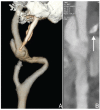Carotid Artery Dissection Caused by an Elongated Styloid Process: Three Case Reports and Review of the Literature
- PMID: 28663957
- PMCID: PMC5364929
- DOI: 10.2176/nmccrj.2014-0179
Carotid Artery Dissection Caused by an Elongated Styloid Process: Three Case Reports and Review of the Literature
Abstract
Eagle syndrome is a set of symptoms associated with an elongated styloid process. Although it is an important cause of cerebrovascular complications such as carotid artery dissection (CAD) or thromboembolism, the condition may be underdiagnosed. We treated three patients with CAD caused by an elongated styloid process within a year. The first patient was a 55-year-old man who developed recurrent thromboembolism despite anticoagulation therapy. Computed tomography (CT) angiography showed bilateral CAD with tips of styloid processes attached to the dissected lesions. He underwent surgical resection of the styloid process followed by carotid artery stenting. The second patient was also a 55-year-old man who developed acute stroke due to carotid artery occlusion, and underwent thrombectomy and carotid artery stenting. Both these patients experienced resolution of their neurological symptoms and had no recurrence of stroke. The third patient was an 80-year-old man with an asymptomatic dissecting aneurysm of the cervical internal carotid artery. He had a history of odynophagia and underwent surgical resection of the styloid process, with resolution of his symptoms. These cases, taken together with recent evidences showing that CAD was associated with the styloid process length, suggest that Eagle syndrome may not be an uncommon cause of CAD. Examination by CT angiography is important to avoid misdiagnosis. A literature review indicates that some cases were refractory to anticoagulation and surgical resection of the elongated styloid process or carotid artery stenting could be a treatment option to prevent further stroke.
Keywords: Eagle syndrome; carotid artery dissection; elongated styloid process; ischemic stroke; stylo-carotid syndrome.
Conflict of interest statement
Conflicts of Interest Disclosure The authors report no conflicts of interest concerning the materials or methods used in this study or the findings specified in this article.
Figures




References
-
- Eagle WW: Elongated styloid process; symptoms and treatment. AMA Arch Otolaryngol 67: 172– 176, 1958. - PubMed
-
- Eagle WW: Elongated styloid processes: report of two cases. Arch Otolaryngol 25: 584– 587, 1937.
-
- Bafaqeeh SA: Eagle syndrome: classic and carotid artery types. J Otolaryngol 29: 88– 94, 2000. - PubMed
-
- Eagle WW: Symptomatic elongated styloid process; report of two cases of styloid process-carotid artery syndrome with operation. Arch Otolaryngol 49: 490– 503, 1949. - PubMed
Publication types
LinkOut - more resources
Full Text Sources
Other Literature Sources
Miscellaneous
